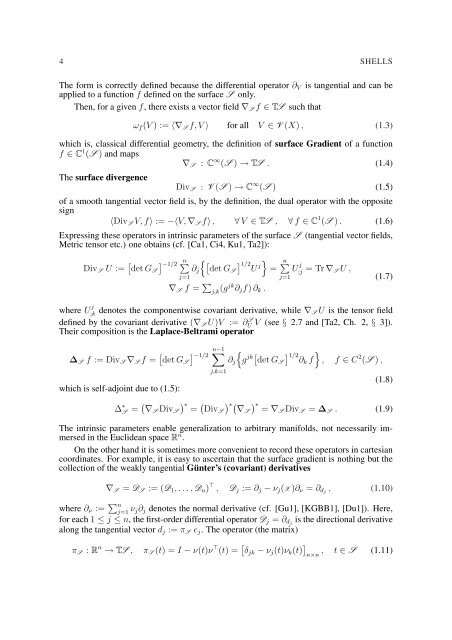EQUATIONS OF ELASTIC HYPERSURFACES
EQUATIONS OF ELASTIC HYPERSURFACES
EQUATIONS OF ELASTIC HYPERSURFACES
Create successful ePaper yourself
Turn your PDF publications into a flip-book with our unique Google optimized e-Paper software.
4 SHELLS<br />
The form is correctly defined because the differential operator ∂ V is tangential and can be<br />
applied to a function f defined on the surface S only.<br />
Then, for a given f, there exists a vector field ∇ S f ∈ TS such that<br />
ω f (V ) := 〈∇ S f, V 〉 for all V ∈ V (X) , (1.3)<br />
which is, classical differential geometry, the definition of surface Gradient of a function<br />
f ∈ C 1 (S ) and maps<br />
∇ S : C ∞ (S ) → TS . (1.4)<br />
The surface divergence<br />
Div S : V (S ) → C ∞ (S ) (1.5)<br />
of a smooth tangential vector field is, by the definition, the dual operator with the opposite<br />
sign<br />
〈Div S V, f〉 := −〈V, ∇ S f〉 , ∀ V ∈ TS , ∀ f ∈ C 1 (S ) . (1.6)<br />
Expressing these operators in intrinsic parameters of the surface S (tangential vector fields,<br />
Metric tensor etc.) one obtains (cf. [Ca1, Ci4, Ku1, Ta2]):<br />
Div S U := [ det G S<br />
] −1/2<br />
n∑<br />
j=1<br />
{ [det ] } 1/2U ∑<br />
j<br />
∂ j GS = n<br />
∇ S f = ∑ j,k (gjk ∂ j f) ∂ k .<br />
j=1<br />
U j<br />
;j = Tr ∇ S U ,<br />
(1.7)<br />
where U j<br />
;k denotes the componentwise covariant derivative, while ∇ S U is the tensor field<br />
defined by the covariant derivative (∇ S U)V := ∂U S V (see § 2.7 and [Ta2, Ch. 2, § 3]).<br />
Their composition is the Laplace-Beltrami operator<br />
∆ S f := Div S ∇ S f = [ ] −1/2<br />
∑n−1<br />
det G S<br />
which is self-adjoint due to (1.5):<br />
j,k=1<br />
∂ j<br />
{g jk[ ] }<br />
1/2∂k<br />
det G S f , f ∈ C 2 (S ) ,<br />
(1.8)<br />
∆ ∗ S = ( ∇ S Div S<br />
) ∗<br />
=<br />
(<br />
DivS<br />
) ∗ (<br />
∇S<br />
) ∗<br />
= ∇S Div S = ∆ S . (1.9)<br />
The intrinsic parameters enable generalization to arbitrary manifolds, not necessarily immersed<br />
in the Euclidean space R n .<br />
On the other hand it is sometimes more convenient to record these operators in cartesian<br />
coordinates. For example, it is easy to ascertain that the surface gradient is nothing but the<br />
collection of the weakly tangential Günter’s (covariant) derivatives<br />
∇ S = D S := (D 1 , . . . , D n ) ⊤ , D j := ∂ j − ν j (X )∂ ν = ∂ dj , (1.10)<br />
where ∂ ν := ∑ n<br />
j=1 ν j∂ j denotes the normal derivative (cf. [Gu1], [KGBB1], [Du1]). Here,<br />
for each 1 ≤ j ≤ n, the first-order differential operator D j = ∂ dj is the directional derivative<br />
along the tangential vector d j := π S e j . The operator (the matrix)<br />
π S : R n → TS , π S (t) = I − ν(t)ν ⊤ (t) = [ δ jk − ν j (t)ν k (t) ] n×n , t ∈ S (1.11)

















